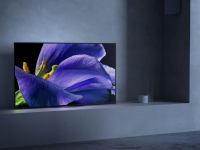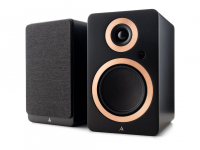
British-based hi-fi manufacturer Roksan had something of an eventful year in 2016. Having been acquired by another British audio stalwart, Monitor Audio, back in December, Roksan became one half of a merger of two of the biggest and most respected hi-fi houses around – a deal which should make for a particularly bright future for both companies…
And whilst Roksan also released a number of new products in 2016, our attentions for today’s review are turned back to a range of products that the London-based brand actually released a short while ago. The Oxygene series marked a dramatic shift in thinking when Roksan unleashed them, utilising technologies and an aesthetic approach that seemingly came out of leftfield, compared to other ranges in the company’s stable of products. That’s not to say that Roksan usually makes plain-jane boxes with ho-hum components tucked inside – far from it – but the approach taken with Oxygene clearly differed from the norm.
Straight out of their packaging the Oxygene range is immediately striking, both in its smaller than average physical stature and the sheer quality of its casework. Indeed, at this or any price point, Roksan have truly excelled in their approach to industrial design. Both the amplifier and the CD player that make up today’s review are housed in particularly solid-feeling metal cabinets – each one 12 x 12 inches square, and a measly 2 inches in height. The rounded edges and lack of any obvious buttons make for a sumptuous looking package.
Whilst the casework itself leans more towards the minimalist side of the design spectrum, the huge dot-matrix style display definitely adds a positively retro touch to proceedings. Easily viewable from across even the biggest of rooms, the display is actually a series of holes drilled into the front fascia. Each hole has a corresponding light behind it which is then lit to show things such as volume and input selection on the amplifier, and track number on the CD player. The display certainly adds to the unique charms of the Oxygene equipment, but it can also be turned off via the equally fancy remote for those that wish to remain undistracted by its bright glow.
One last design quirk worth a mention is the use of the words ‘Less Is More’ on the top of the casework for both amplifier and CD player. No mere pithy slogan, each of these engraved words acts as a touch button to operate certain aspects of each component. For example, touching the word ‘More’ on the top of the amplifier will increase the volume, whilst touching ‘Less’ will decrease it. Try the same on the CD player and you’ll skip track forward or backwards depending on which word is pressed. ‘Is’ acts as an input select or play/pause button on each device, meaning all basic operations are covered by these very discreet and thoughtful engravings. See, we told you it was unique!

Underneath the fancy housing, both Oxygene products keep up the good impressions. Looking at the amplifier first, Roksan has packed in a Class-D (digital) amplifier. This type of amplification allows for such slim casing, requiring less space than traditional analogue amps. Power is not a problem either, with the Roksan kicking out a hefty 75 Watts per channel (wpc) into an 8 ohm load, doubling to 150 wpc when a 4 ohm load is driven. This substantial output is made possible by two toroidal power supplies, set up in a dual-mono design for maximum interference and crosstalk reduction. Connectivity is good, with the amplifier offering three RCA line inputs connections, as well as a wireless link in the form of Bluetooth – pretty forward thinking for its time. The output is to one pair of speakers only, with a pair of banana inputs used in favour of binding posts.
Elsewhere, the CD player is fitted with a high-quality Burr-Brown DAC chip and features both analogue and digital outputs for easy connection to the matching amplifier or to a separate DAC. Roksan also has a CD transport available in the Oxygene range, so anybody in the market for a high-end transport to use with an external DAC would be well advised to give it the once over.
In the course of testing the equipment, we tried a number of speakers in search of a perfect match. What became apparent during listening was that the Oxygene equipment fell very much into the ‘neutral’ category of hi-fi components, seemingly favouring no particular brand of the speaker over another. Its recent tie-in with Monitor Audio makes the Silver range of speakers and an excellent choice to match up, and we got great results when pairing the Roksan to the Silver 8 floorstanders. The amplifier and CD player were given a lengthy running in before serious listening commenced, giving them a proper chance to shine.
First up was the late, definitely great, George Michael and his superb Cowboys and Angels, taken from the album Listen With Prejudice Vol. 1, released in 1990. One of Michael’s finest songs, it was also one of the worst charting of his tracks to be released in the UK, coming in at number 45 on initial release. This fact takes none of the shine off its gorgeous production, with the song’s bassline and lush saxophone making for an immensely satisfying listen. That bassline is the first thing that showed the Roksan’s quality as the track got underway, with the tone and depth of the lower frequencies filling the room superbly. There was an undoubted weight to the track, showing a real fullness and sense of body, but without over-shadowing the rest of the frequency range. Because of this, the accompanying percussion was easy to hear and follow, sounding just as light and airy as Michael’s pretty much perfect vocal. By the time the sax solo kicks in, the sense of realism and naturalness of the performance was obvious, definitely helped along by the Roksan’s impeccable sense of timing and neutrality.
 Moving on, we fired up the latest album from one-time “psych-rockers”, now “psych-whatevers”, The Flaming Lips. Oczy Mlody, their 14th full-length release, sees the band move further away from live instrumentation and into a hip-hop and electronica-inspired groove that’s at least partly influenced by their recent work with pop rebel, Miley Cyrus. Single How? is a great representation of the album’s ideas and sounds, with heavy bass wobbles, tinny drum loops and Wayne Coyne’s distorted and manipulated vocals. So much nuance in a track requires great resolution and detail retrieval, as well as a balanced performer to get a handle on everything, and the Roksan proved itself to be more than up to the task. That sense of bass weight was obvious again, but as before, it never overpowered the sounds elsewhere unless intentional. Coyne’s ethereal vocals hung in the air, central in the mix, with all of the other audio wizardry pulsing around the listening room. The effect of space and distance was hugely impressive and the Roksan deserved credit for how well it gave a sense of scale.
Moving on, we fired up the latest album from one-time “psych-rockers”, now “psych-whatevers”, The Flaming Lips. Oczy Mlody, their 14th full-length release, sees the band move further away from live instrumentation and into a hip-hop and electronica-inspired groove that’s at least partly influenced by their recent work with pop rebel, Miley Cyrus. Single How? is a great representation of the album’s ideas and sounds, with heavy bass wobbles, tinny drum loops and Wayne Coyne’s distorted and manipulated vocals. So much nuance in a track requires great resolution and detail retrieval, as well as a balanced performer to get a handle on everything, and the Roksan proved itself to be more than up to the task. That sense of bass weight was obvious again, but as before, it never overpowered the sounds elsewhere unless intentional. Coyne’s ethereal vocals hung in the air, central in the mix, with all of the other audio wizardry pulsing around the listening room. The effect of space and distance was hugely impressive and the Roksan deserved credit for how well it gave a sense of scale.
Throughout our listening session, the Roksan Oxygene equipment continued to impress. The harsh and brash sound often associated with digital amplification was nowhere to be found, with a true “hi-fi” sound to match up to the equally impressive visuals. For products that fit into such small cases, the Oxygene gave no impression of being any other than a serious audio system, one that would easily take pride of place in any home and with almost any set of speakers. If you’re in the market for an amplifier, CD player or both, then the Roksan Oxygene components are an absolute must audition.
To hear how good the Roksan Oxygene range sounds for yourself, please call or visit your local Richer Sounds for a demo today!
Shop with Richer Sounds today.
Author: Chris, Liverpool store






A good review of a good product.
One point however, the “D” in a class D amplifier does not stand for “Digital”
any more than the “A” in a class A amp means “Analogue”
For more information about amplifier classes take a look at http://www.soundonsound.com/techniques/what-class-d-amplification.
How does the Oxygene amp compare with the amp of the Cyrus Lyric 09, both of which are class D?